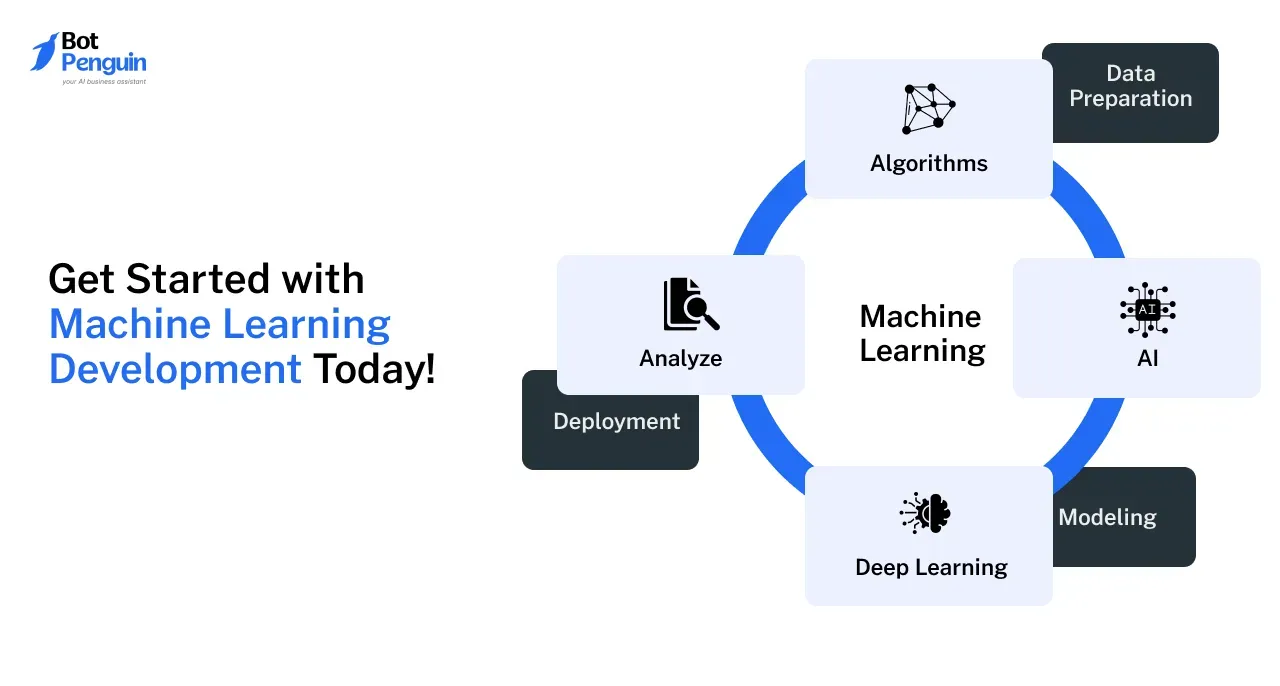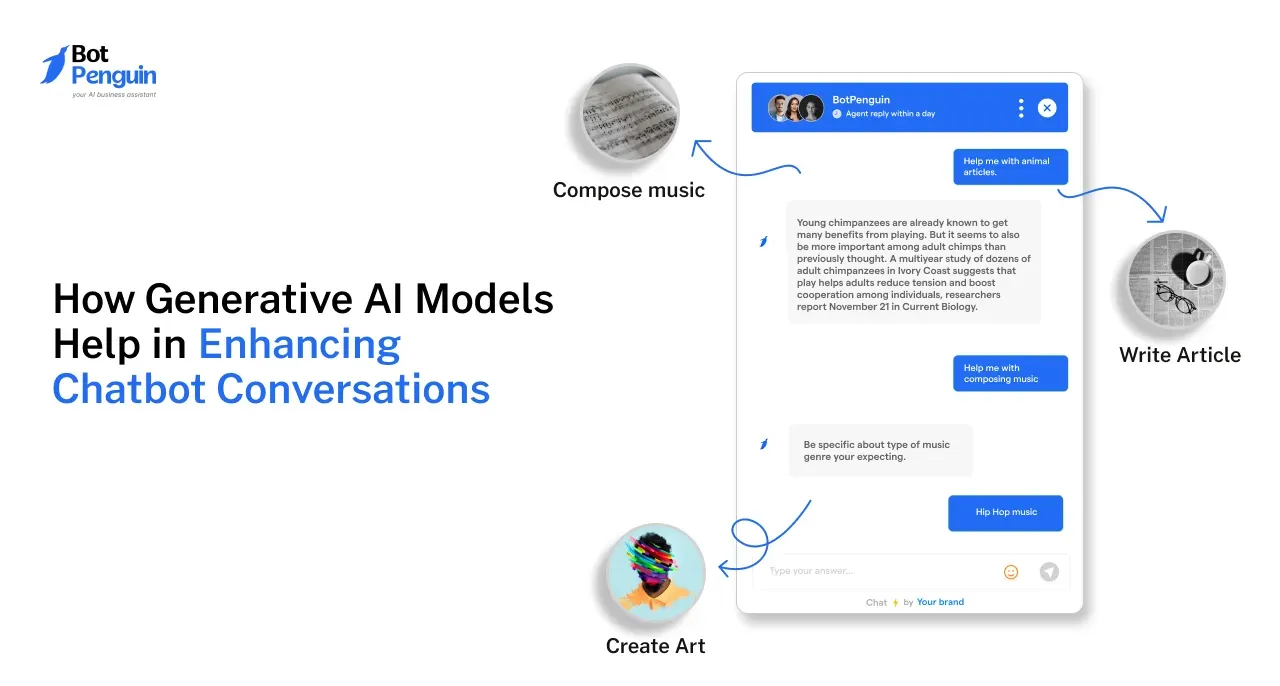Imagine waking up to a world where your morning coffee is brewed to perfection based on your previous tastes, or where your favorite online store predicts exactly what you’ll want next.
This isn’t just a futuristic fantasy; it’s the power of machine learning development at work. As we step into an era where technology evolves at an unprecedented pace, machine learning development is revolutionizing every aspect of our lives—from healthcare and finance to entertainment and retail.
As of 2023, the global machine learning development market is projected to reach $21.17 billion, with an expected compound annual growth rate (CAGR) of 39.2% from 2023 to 2030.
This growth underscores the increasing adoption of machine learning development technologies across various sectors, including healthcare, finance, and retail. It highlights its pivotal role in shaping the future of industries worldwide.[source: Fortune Business Insight]
In this blog, we’ll embark on a journey through the intricacies of machine learning development, exploring its key concepts, real-world applications, and the transformative impact it has on industries and our daily routines.
Whether you’re a curious beginner or an aspiring developer, you’ll discover how machine learning development services can enhance your projects and how partnering with a qualified machine learning development company can streamline your path to success.
We’ll also discuss innovations like the HPE machine learning development system that are setting the stage for advanced capabilities.
Let’s dive in and unravel the magic behind the algorithms that are changing our world for the better.
What is Machine Learning?
Machine learning development focuses on teaching machines to interpret data and learn from it, enabling them to improve over time without explicit programming.
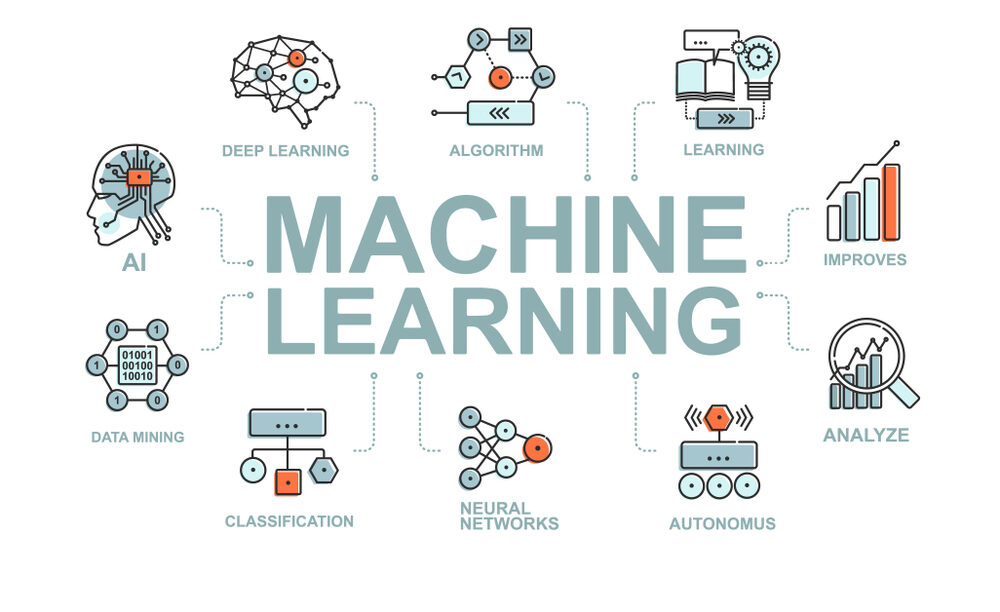
This approach allows computers to discover patterns and make data-driven decisions rather than following set rules.
Difference between AI, Machine Learning, and Deep Learning
Following are the differences and definitions highlighted between the three :
- Artificial Intelligence (AI): AI is the overarching concept of machines performing tasks that we consider "intelligent." AI includes a wide range of techniques, including both machine learning and deep learning, that enable machines to simulate human intelligence.
- Machine Learning: A subset of AI, machine learning development uses algorithms to process data, learn from it, and make decisions or predictions based on those insights.
It is foundational to Machine Learning Development, allowing systems to adapt to new data.
- Deep Learning: Deep learning is a specialized area within machine learning that utilizes artificial neural networks. Inspired by the human brain’s structure, deep learning algorithms learn data representations at multiple levels, making them especially effective for complex data tasks like image recognition and natural language processing.
Types of Machine Learning
Machine learning development includes four main types: supervised, unsupervised, semi-supervised, and reinforcement learning.
Supervised Learning
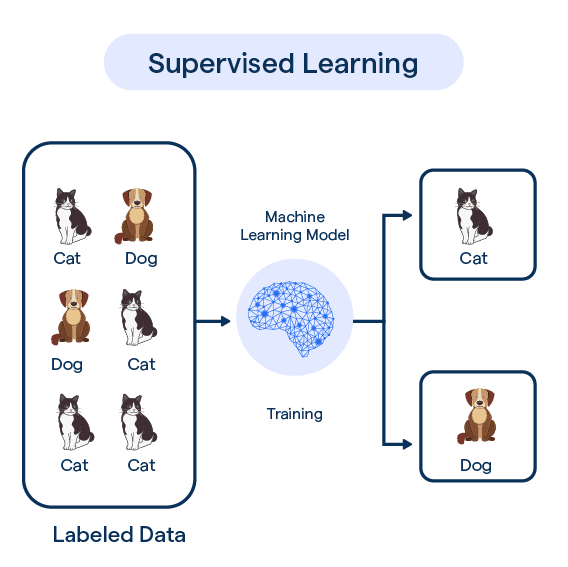
Machine Learning Development commonly begins with supervised learning, where models learn from labeled datasets, helping them map inputs to outputs accurately.
- Applications: Predicting house prices, email classification, and medical diagnostics.
- Common Algorithms: Linear regression, logistic regression, support vector machines.
Supervised learning is especially valuable for tasks with clearly defined outputs, as it allows Machine learning development Services to achieve high precision through labeled data training.
Unsupervised Learning
In unsupervised learning, Machine learning development focuses on finding hidden patterns in unlabeled data, making it ideal for exploratory tasks.
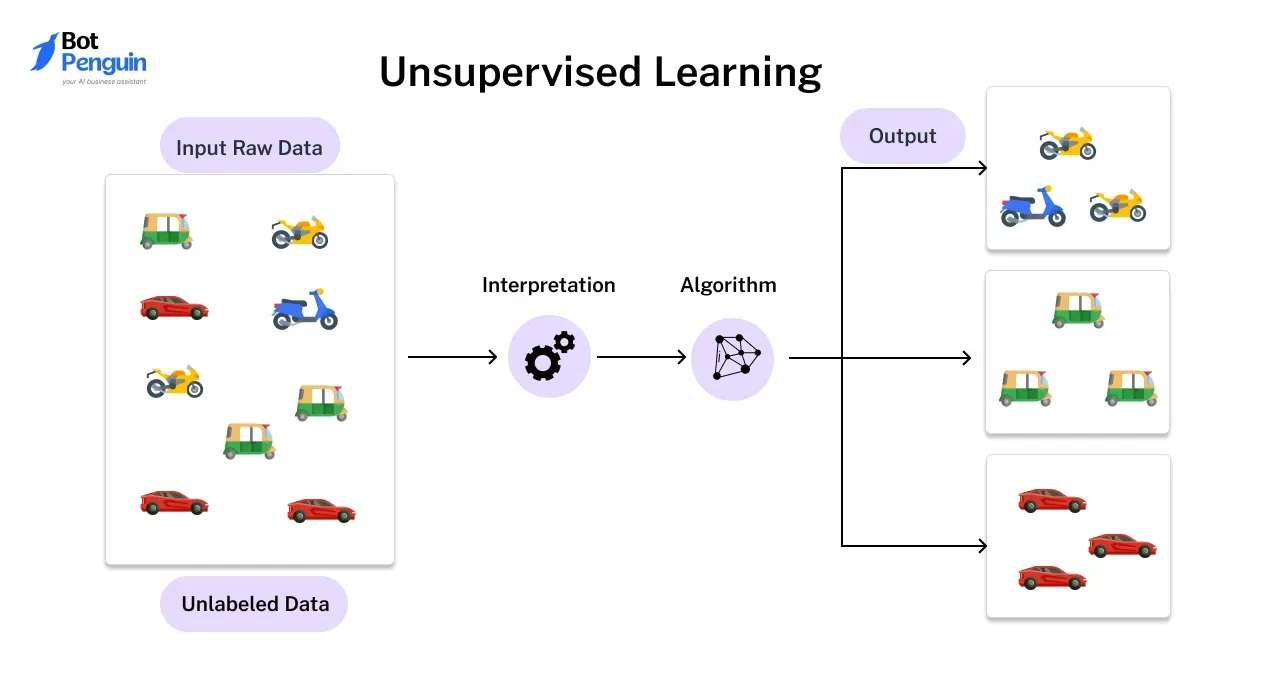
- Applications: Customer segmentation, market basket analysis, anomaly detection.
- Common Algorithms: K-means clustering, hierarchical clustering, PCA.
By discovering groupings within data, unsupervised learning aids in data analysis and pattern recognition. Many Machine learning development Services use it for market analysis and other applications without clear labels.
Semi-Supervised Learning
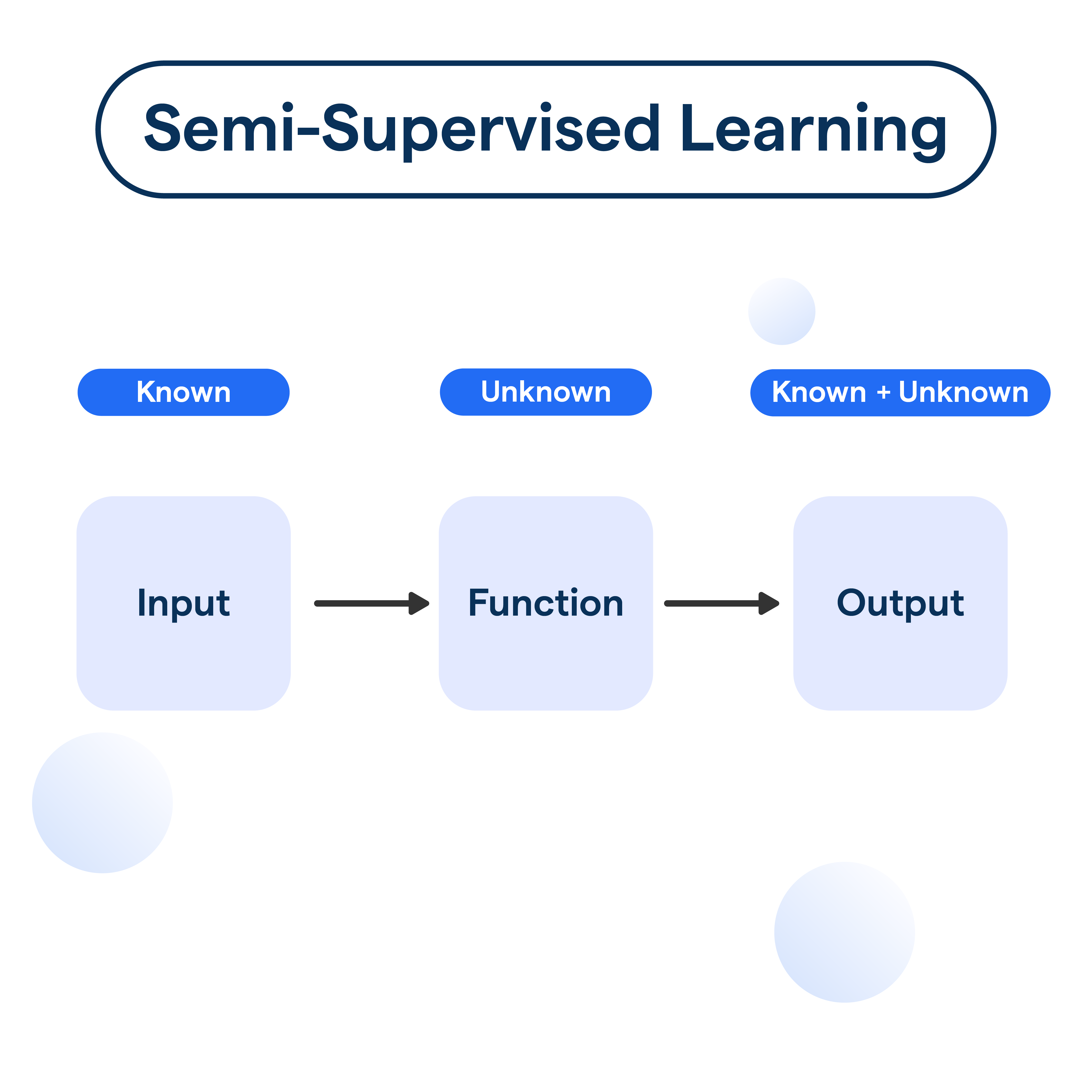
Semi-supervised learning combines aspects of both supervised and unsupervised learning, utilizing a mix of labeled and unlabeled data.
- Applications: Image classification, speech recognition, text processing.
- Common Algorithms: Self-training, co-training, multi-view learning.
Semi-supervised learning is ideal when labeled data is limited but unlabeled data is abundant, as it enhances accuracy. Many Machine learning development Companies rely on this approach to optimize resources and improve learning efficiency.
Reinforcement Learning
Reinforcement learning is crucial in Machine learning development when an agent needs to learn actions through feedback from its environment, aiming to maximize cumulative rewards.
- Applications: Robotics, game strategy, autonomous driving.
- Common Algorithms: Q-learning, deep Q networks (DQN), policy gradients.
Key Concepts in Machine Learning Development
Getting familiar with the core concepts of Machine learning development is vital to building effective models and making informed decisions.
Here, we’ll explore the importance of data, the role of algorithms, and the training and testing processes that shape successful machine learning projects.
Data: Importance and Types
Data is the backbone of Machine learning development, serving as the material that algorithms analyze to produce insights or make decisions.
- Structured Data: This type of data is organized in a well-defined format, like tables in a database. Examples include customer transaction records or inventory databases, which are easy for algorithms to interpret.
- Unstructured Data: Unstructured data includes more complex forms such as images, audio, videos, and text documents. For example, e-commerce reviews or social media posts fall under this category.
- Semi-structured Data: Combining aspects of both, semi-structured data (like JSON files) mixes structured data elements with unstructured data, making it flexible yet still interpretable for machine learning development models.
Algorithms: What they are and Common Types
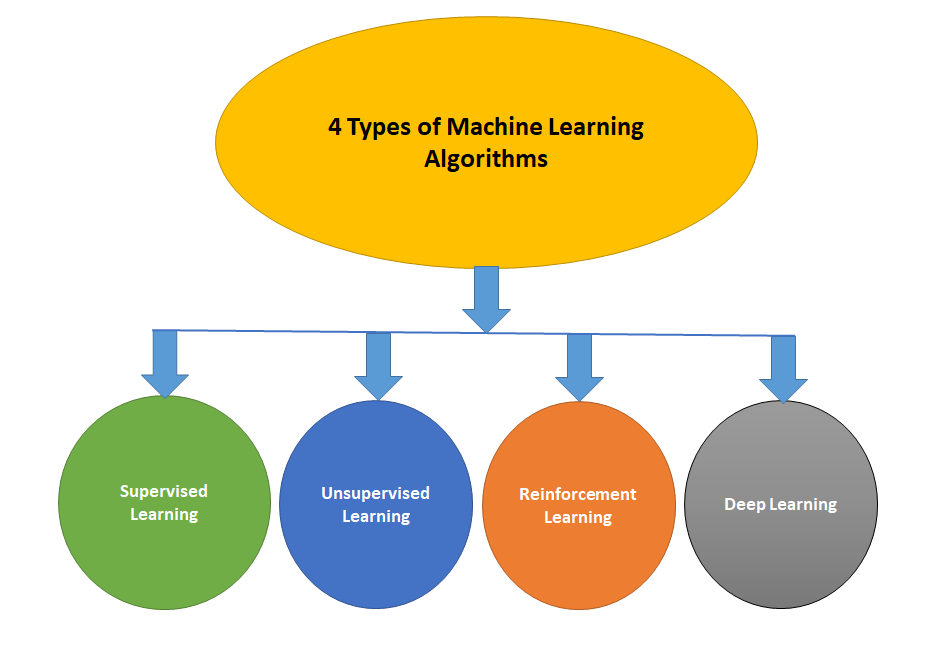
Algorithms are the core of Machine learning development, transforming raw data into insights by processing it into predictive models.
Machine Learning Development involves a variety of algorithm types:
- Supervised Learning Algorithms: These algorithms learn from labeled data. For example, in a retail setting, a model might be trained to predict customer purchase behavior based on past transactions.
- Unsupervised Learning Algorithms: With unlabeled data, these algorithms uncover hidden patterns or groupings, such as clustering customers based on buying habits.
This approach is popular in customer segmentation and market research.
- Reinforcement Learning Algorithms: These algorithms learn through a system of rewards and penalties. For instance, reinforcement learning drives innovations in autonomous driving, where the model learns from environment interactions to navigate safely.
Models: Training and Testing
In Machine Learning Development, models are built by applying algorithms to data, which allows them to make predictions or classify information.
- Training: The training phase involves feeding a model with data and adjusting parameters to minimize prediction errors. For instance, a company might train a model to recognize customer complaints in emails, teaching it patterns in language indicative of a complaint.
- Validation: This fine-tuning step is crucial for selecting the best-performing model while preventing overfitting. Validation is particularly useful when working with data from diverse sources, ensuring models perform well across different datasets.
- Testing: Testing on new data measures the model’s accuracy, precision, and other metrics. For example, a healthcare company might evaluate a model that predicts patient readmission rates, testing it on a separate dataset for accuracy.
Tools and Technologies
.webp)
Selecting the right tools and technologies is fundamental for effective Machine Learning Development. The following are some essential resources that can streamline the development process.
Mathematics
Mathematics is essential to Machine Learning Development, enabling a deeper understanding of algorithms and optimizations for model performance.
- Linear Algebra: Core to representing data, vectors, and matrices are crucial in image recognition and other data-rich fields.
- Calculus: Used in optimizing models by computing gradients, calculus is vital for model training.
- Probability and Statistics: Probability distributions and Bayes’ theorem play a key role in predictive modeling.
- Optimization: Stochastic Gradient Descent is widely used for large datasets, as it incrementally updates parameters for quicker optimization.
Programming Languages: Python and R
Programming languages are the foundation for implementing Machine learning development projects.
- Python: Python’s simplicity and vast ecosystem make it the most popular choice in the field. Many companies use Python for tasks ranging from predictive analytics to real-time fraud detection.
- R: Known for its capabilities in statistical analysis and visualization, R is common in academic research and data exploration, especially when in-depth data analysis is required.
Libraries: TensorFlow, Keras, Scikit-learn
Libraries simplify the implementation of machine learning algorithms and provide pre-built functions that save time.
- TensorFlow: TensorFlow is a powerful library developed by Google, and widely used in deep learning. For instance, it’s applied in image recognition tasks across healthcare and automotive industries.
- Keras: Built on TensorFlow, Keras allows for rapid prototyping of neural networks. Its user-friendliness has made it popular for both beginners and professionals working on deep learning projects.
- Scikit-learn: Known for classical machine learning development, Scikit-learn is ideal for clustering, classification, and regression tasks, making it useful for a range of Machine learning development Services.
Development Environments: Jupyter Notebook, Google Colab
Development environments help streamline the coding and experimentation process in Machine learning development
- Jupyter Notebook: Ideal for interactive data analysis, it’s used widely by data scientists for data cleaning and visualization.
- Google Colab: With free access to GPUs, Google Colab allows users to run complex models without needing powerful local hardware, making it perfect for collaborative deep-learning projects.
Step-by-Step Guide to a Simple Machine Learning Development Project
Developing a machine learning model follows a structured process, each step crucial for building a robust and accurate model.
Let’s go through a detailed example of a project, such as predicting house prices, to illustrate each stage.
Step 1
Define the Problem
In machine learning development, it’s essential to clarify the problem you’re aiming to solve.
In our house price prediction example, the objective is to predict the sale price of a house based on various characteristics (like square footage, location, and number of bedrooms).
Defining the problem includes identifying the outcome variable (house price) and the predictor variables that might affect it.
Example: A real estate company might want to predict the selling price of homes in a specific region to help homeowners set competitive prices or assist buyers in estimating their budgets. By predicting prices accurately, the company can also provide valuable insights to mortgage lenders, appraisers, and market analysts.
Step 2
Collect Data
Data is the backbone of machine learning development. This step involves gathering data from reliable sources, which can include online datasets or proprietary company data.
For house prices, relevant data sources might be real estate sites like Zillow or Kaggle datasets.
Example: Suppose a real estate company wants to train a model to predict house prices. They could collect data on factors like the square footage, location, age of the house, and recent sale prices from platforms like Zillow or the UCI Machine Learning Repository. Alternatively, they could use their own historical data if available.
Step 3
Prepare Data
After data collection, data preparation is crucial. This step involves cleaning, processing, and transforming the raw data to make it suitable for machine learning development.
Missing values, duplicates, and inconsistencies need to be addressed for accurate model predictions.
- Cleaning: Remove duplicates, handle missing values by filling in reasonable defaults (like the average for numerical values), or removing incomplete records.
- Preprocessing: Convert data into a machine-readable format. Numerical features might be normalized to ensure consistency, while categorical data (e.g., neighborhood names) can be encoded as numbers.
Example: For a house price prediction model, features such as square footage, location, and number of bedrooms might need normalization and encoding.
For instance, high-priced areas like downtowns might be labeled as ‘1,’ while suburban neighborhoods as ‘0.’
Suggested Reading:
Machine Learning Development: Trends and Predictions
Step 4
Choose an Algorithm
The choice of algorithm depends on the nature of the problem. Machine learning models can be divided into regression, classification, and clustering types.
House price prediction falls under regression, as it involves predicting continuous values.
- Regression Algorithms: For predicting continuous values, like house prices, Linear Regression or Decision Trees are effective starting points.
- Classification Algorithms: Used when categorizing data into classes. For instance, if you were classifying houses as ‘affordable’ or ‘luxury,’ Logistic Regression or Decision Trees could work.
- Clustering Algorithms: Suitable for grouping data without labels, such as customer segmentation in real estate based on buying preferences. K-means clustering is often used here.
Example: For predicting house prices, Linear Regression is a good starting point because it models the relationship between features (e.g., square footage, location) and the target variable (price).
Step 5
Train the Model
Training involves feeding the prepared data into the algorithm so the model can learn patterns. This process varies by algorithm but typically involves adjusting parameters to minimize prediction errors.
Example: In Linear Regression, training involves finding the best-fit line that predicts house prices based on features like size, age, and location. The model adjusts until it finds the optimal coefficients that minimize the error between predicted and actual prices.
Step 6
Evaluate the Model
Once the model is trained, it’s essential to evaluate its performance on new data, typically through metrics that assess accuracy and error. Common metrics in regression problems include:
- Mean Absolute Error (MAE): Measures the average error between predictions and actual values.
- Mean Squared Error (MSE): Similar to MAE but penalizes larger errors more heavily.
- R-squared: Indicates how well the model explains the variability of the outcome.
Example: After training a Linear Regression model on historical house price data, you evaluate it by comparing predicted prices with actual prices in a separate test dataset.
For instance, if your model predicts a house price as $250,000 but the actual price is $260,000, MAE and MSE metrics quantify this difference, helping refine the model’s accuracy.
Step 7
Tune the Model
Model tuning, or hyperparameter optimization, aims to improve the model’s performance.
Techniques such as grid search or random search adjust parameters to find the optimal configuration for accuracy.
Step 8
Deploy the Model
Deployment involves making the model accessible for real-world use, often by integrating it into applications. Users can input data into the model to receive predictions or insights.
Example: A real estate company might deploy the model within a web app, where users can enter house features to get a price estimate instantly.
This deployed model could support agents, buyers, and sellers by offering quick, data-backed price predictions, enhancing customer engagement and operational efficiency.
Data Collection and Preparation
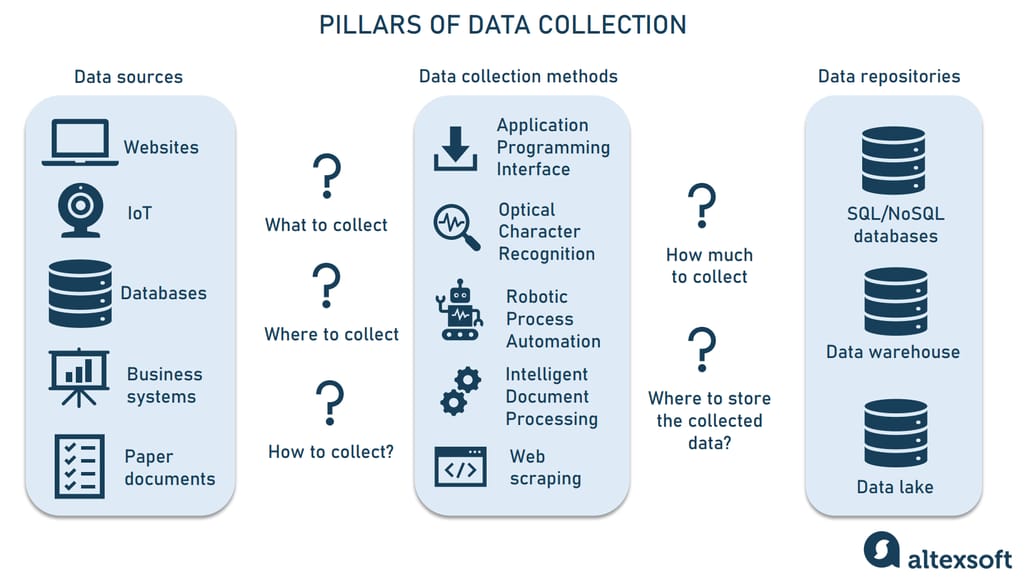
Data is the cornerstone of any successful machine learning project. Without high-quality data, even the best algorithms can fail to deliver meaningful results.
The process of data collection and preparation requires attention to ensure the data accurately represents the problem at hand.
Collect Data
For machine learning, data can come from various sources, including online datasets, sensors, or company databases.
For a house price model, historical property sales data might include features such as:
- Square footage
- Number of bedrooms and bathrooms
- Location (ZIP code or city)
- Age of the house
- Proximity to amenities (schools, shopping centers)
Clean Data
Cleaning is essential to address missing, inconsistent, or duplicated data that could skew results.
- Handling Missing Values: Use techniques like imputation to fill missing values or remove rows with excessive missing data.
- Removing Duplicates: Ensure that duplicate entries are eliminated.
Suggested Reading:
Machine Learning Development in Action: Real World Use-Cases
Preprocess Data
Preprocessing includes normalizing numerical data, encoding categorical data, and dividing the dataset for training and testing.
Example: Suppose the house price data includes categorical values like "urban" or "suburban" for location. Encoding these as numerical values makes the data usable by the model. Similarly, numerical features like price may be scaled to improve model accuracy.
Choosing an Algorithm
The selection of an algorithm is a critical decision in machine learning development. The right algorithm depends on the data type and the project goal.
Example: Linear Regression is a natural choice for predicting house prices. However, if the data shows complex relationships, advanced algorithms like Decision Trees or Random Forests may offer improved accuracy.
Training and Evaluating the Model
This phase is where the algorithm learns from the data and is assessed for its ability to generalize.
Example: By training a Linear Regression model on house prices, the model finds relationships between input variables (e.g., square footage) and the target (price). The evaluation phase tests the model’s performance, often through an R-squared metric, to see how well it predicts prices in new data.
Real-World Applications of Machine Learning Development
Machine learning (ML) development is transforming industries globally, bringing efficiency, automation, and insight. Let’s explore how specific industries use ML to drive innovation and address complex challenges.
Healthcare

In healthcare, machine learning development plays a crucial role in patient care and operational efficiency.
Algorithms analyze medical images like X-rays, MRIs, and CT scans to detect diseases such as cancer at early stages, offering greater chances for successful treatment.
Machine learning development also supports predictive analytics to identify patients at risk for conditions like diabetes or heart disease, enabling early intervention.
Example: IBM Watson Health uses machine learning to analyze extensive medical data, improving diagnosis accuracy and treatment recommendations.
Watson's oncology system has been used in several hospitals to assist doctors by suggesting treatment plans based on the patient’s unique data and comparing it with thousands of cases.
In some cases, Watson has successfully identified cancer types that conventional methods missed, demonstrating the potential of ML to enhance diagnostic accuracy.
Retail
Retailers use machine learning development to boost customer engagement, refine pricing strategies, and optimize inventory management.
By analyzing customer data such as browsing history, purchase patterns, and preferences, ML algorithms provide personalized recommendations, helping to increase sales and customer satisfaction.
Example: Amazon’s recommendation engine utilizes ML to suggest products based on a customer’s viewing and purchasing history. The recommendation system reportedly accounts for 35% of Amazon’s sales, reflecting the power of personalized suggestions.
With these advanced ML techniques, retailers can significantly improve their Machine Learning Development Services for targeted marketing.
Finance
In the finance sector, machine learning development enables accurate fraud detection, automated trading, and credit risk assessment.
Algorithms analyze historical transaction data, identifying unusual patterns that could signify fraudulent activity, often detecting anomalies faster than traditional methods.
Example: PayPal’s fraud detection system uses machine learning to monitor billions of transactions annually.
Its ML models analyze variables like purchase history, location, and transaction patterns to detect suspicious activities, resulting in a 50% reduction in fraudulent transactions.
Financial institutions are increasingly partnering with specialized Machine Learning Development Companies to enhance their fraud detection systems and improve security.
Manufacturing
In manufacturing, machine learning development supports quality control, predictive maintenance, and production optimization.
By analyzing sensor data from machinery, ML models detect patterns that indicate equipment malfunctions, preventing costly breakdowns.
Example: General Electric (GE) uses machine learning to predict maintenance needs in their industrial equipment.
ML-driven predictive maintenance has helped GE avoid unplanned downtime, which could cost industrial manufacturers an average of $50 billion annually, according to a study by Aberdeen Research.
Additionally, leveraging solutions like the HPE Machine Learning Development System can further enhance predictive maintenance capabilities across the manufacturing sector.
Suggested Reading:
A Review on Machine Learning Development for Businesses
Future Trends and Possibilities of Machine Learning Development
Machine learning is advancing rapidly, with emerging trends poised to reshape its applications across industries. Below are some of the key trends and their potential impacts:
Advancements in Deep Learning for NLP and Computer Vision
Deep learning models, particularly in natural language processing (NLP) and computer vision, are achieving higher accuracy and efficiency.
These advancements enable applications such as real-time language translation and autonomous driving.
Example: Google Translate's neural machine translation uses deep learning to improve translation accuracy across over 100 languages.
Similarly, Tesla’s Autopilot system leverages computer vision to interpret real-time road conditions, aiming to enable fully autonomous driving.
Explainable AI (XAI)

As machine learning development models become more integral to critical industries, understanding and interpreting model decisions is crucial.
Explainable AI addresses this need by providing transparency and insights into how ML models make predictions, which is particularly valuable in sectors like healthcare and finance.
Example: DARPA’s XAI program aims to develop explainable AI systems, enabling healthcare providers to understand why a model suggests a particular diagnosis or treatment, increasing trust, and aiding regulatory compliance.
Integration of ML with the Internet of Things (IoT)
Combining machine learning with IoT allows for real-time data processing, which has applications in smart cities, manufacturing, and logistics.
Predictive maintenance in factories and traffic management in smart cities are examples of IoT-ML integration.
Example: Siemens Smart Cities uses ML and IoT to optimize traffic flow in urban areas, reducing congestion and lowering emissions. A study by Juniper Research projects that smart cities using IoT and ML could reduce urban emissions by 15% by 2030.
Federated Learning for Data Privacy

Federated learning allows ML models to train on data from decentralized devices without requiring data centralization, preserving privacy and enhancing security.
This approach is particularly beneficial in sensitive fields like healthcare, where patient data privacy is paramount.
Example: Google’s Gboard keyboard app uses federated learning to improve predictive text features without uploading user data to central servers. This model allows the app to learn from user inputs while ensuring privacy.
Economic Growth and Market Expansion
According to Gartner’s 2023 report, the global AI market, including machine learning, is expected to expand significantly, growing from $62 billion in 2022 to $158 billion by 2027 (a CAGR of 21%).
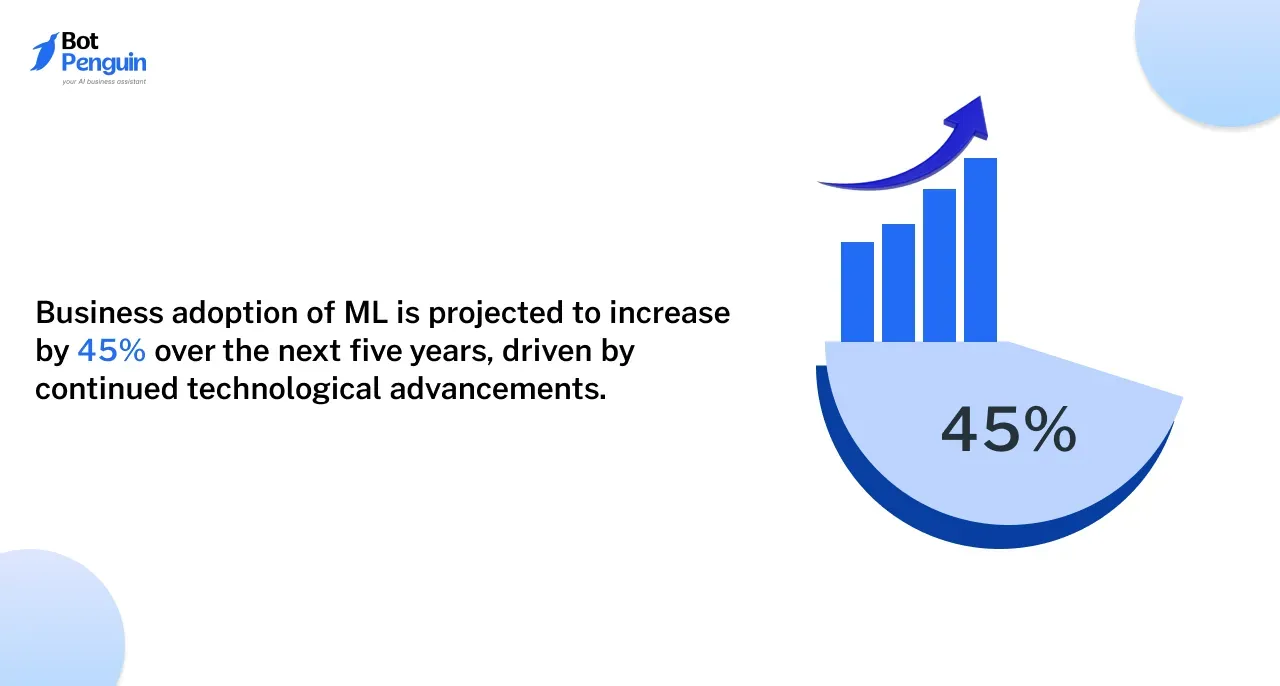
Furthermore, business adoption of ML is projected to increase by 45% over the next five years, driven by continued technological advancements and increased investment in AI research
As adoption grows, sectors like healthcare, retail, and finance are expected to see substantial gains. A report by McKinsey highlights that businesses using AI in customer service and support can improve customer satisfaction by 10-15% while reducing response times by up to 40%.
Conclusion
In conclusion, machine learning development is revolutionizing various industries by enhancing efficiency, improving decision-making, and driving innovation.
From healthcare applications that aid in disease detection to retail systems that personalize customer experiences, the transformative potential of ML is evident across the board.
As we move forward, trends like deep learning advancements, explainable AI, and federated learning will further shape the future landscape, making ML more accessible and impactful.
Businesses looking to harness the power of machine learning can benefit significantly from integrating AI-driven solutions and leveraging Machine Learning Development Services into their operations.
BotPenguin stands out as an exceptional choice for companies aiming to implement AI chatbots and streamline customer interactions.
With its user-friendly platform and robust features, BotPenguin empowers businesses to enhance customer engagement and automate processes effectively, making it an ideal partner in your machine learning journey.
Additionally, partnering with a reputable Machine Learning Development Company can further accelerate your progress in this domain.
Embrace the future of technology with BotPenguin and unlock the full potential of machine learning, including solutions like the HPE Machine Learning Development System, for your business!
Frequently Asked Questions(FAQs)
What is machine learning development?
Machine learning development is a subset of artificial intelligence (AI) that enables computers to learn from data and make predictions or decisions without being explicitly programmed for each task.
This approach involves using algorithms and statistical models to improve performance over time as the system processes more data. Many companies now seek specialized Machine Learning Development Services to enhance their capabilities.
What programming languages are best for machine learning development?
For machine learning development, Python is the most popular programming language due to its ease of use and extensive libraries.
R is also highly regarded, particularly for statistical analysis and data visualization, making it a valuable tool for machine learning development.
Choosing the right Machine Learning Development Company can also provide access to expert guidance on the best programming languages for your specific projects.
What are the essential tools for machine learning development?
Key tools for effective machine learning development include TensorFlow, PyTorch, and Scikit-learn. These powerful frameworks help developers build, train, and deploy machine learning models efficiently, allowing for streamlined workflows in machine learning development projects.
Companies leveraging HPE Machine Learning Development System can also benefit from advanced tools that enhance their machine learning capabilities.
How do I set up my environment for machine learning development?
To set up your environment for machine learning development, start by installing Python and Anaconda. Next, install essential libraries like TensorFlow, PyTorch, and Scikit-learn.
Utilizing Jupyter Notebooks can enhance your experimentation process, enabling you to write and test code interactively. If you're working with a Machine Learning Development Company, they can assist you in setting up an optimal environment tailored to your project needs.
What are the basic prerequisites for learning machine learning development?
Before diving into machine learning development, it’s beneficial to have a foundational understanding of statistics, probability, linear algebra, calculus, and programming—particularly in Python.
These concepts are critical for grasping the principles behind machine learning algorithms. Engaging with Machine Learning Development Services can provide valuable resources and mentorship to accelerate your learning.
What are the future trends in machine learning development?
The future of machine learning development is promising, with several trends emerging, including AutoML, AI applications in healthcare, edge computing, ethical AI considerations, and utilizing machine learning development to combat climate change.
Significant growth in machine learning development adoption is anticipated by 2027, and companies investing in HPE Machine Learning Development System are likely to stay ahead of the curve.
